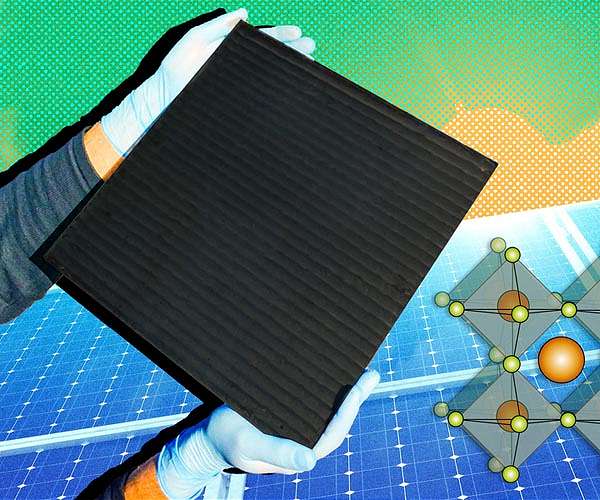BENGALURU, India (AP) – In May last year, Fortum India, a subsidiary of a Finnish solar developer, won the bid for a solar power project in the state of Gujarat. The project was scheduled for completion three months ago and would have generated enough electricity for 200,000 homes.
But like many other solar projects in the country, it has been delayed as Fortum India struggles to source and pay for the necessary components.
“Over the past six months, we haven’t been able to finish new project development,” said Manoj Gupta, who oversees Fortum India’s solar projects in India.
Gupta said solar panels and cells have become extremely expensive because of protective taxes that the Indian federal government implemented in April last year. Basic customs duty imposes a duty of 40% on imported solar modules and 25% on solar cells.
The government says it wants to encourage the domestic manufacture of components needed to produce solar energy and reduce the country’s dependence on imports.
But solar developers say local producers, while growing rapidly and driven by policy initiatives, are still too young to meet demand. Current cell and module manufacturing capacity in India is around 44 gigawatts per year, just a fraction of what is needed to meet India’s renewable targets.
By 2022, India was targeting to install 100 gigawatts of solar power as part of its goal to add 175 gigawatts of clean electricity to its grid. But only 63 gigawatts of solar power were installed last year, according to data from the Indian federal government. India missed its 2022 renewable energy target by just nine gigawatts.
“Without these obligations, we would have easily achieved our targets for larger solar projects, at least,” said Jyoti Gulia of renewable energy research and consulting firm JMK Research.
Most solar developers in India and around the world rely on China, with the country producing more than 80% of the world’s solar components, according to the International Energy Agency. Many countries have tried to encourage domestic production to limit the country’s dependence. The recent climate law in the United States, for example, also encourages home-made renewable energy.
“China controls the market and we saw during the pandemic and the geopolitical conflict between our countries that they just completely disrupted the supply chain,” said Chiranjeev Saluja of Indian solar manufacturer Premier Energies. “I think the government wants to develop the entire solar ecosystem, that is the intention behind these policies.”
Saluja added that a bustling solar manufacturing industry also has broader economic benefits.
“Manufacturing jobs are well-paying, safe jobs. And while developers only employ a handful of people, to manufacture the cells needed to produce a gigawatt of solar power, you’ll need at least 500 people,” he said.
A 2022 report found that India’s renewable energy sector could employ over a million people by 2030, but only if domestic manufacturing continues to increase sharply.
Another Indian government policy requiring that solar components can only be purchased from government-approved manufacturers to ensure the modules and cells are of good quality is also holding back projects, according to analysts.
Developers cannot buy from Southeast Asian countries as manufacturers have yet to be approved or have not applied. Many of these countries have free trade agreements with India that would make them exempt from import duties.
“The situation is pretty bleak today,” said Vinay Rustagi, managing director of renewable energy consultancy Bridge to India. “Global supply chain issues, material shortages and, of course, the tax on solar components have led to the postponement of many projects.”
Rustagi said the domestic manufacturing growth as a result of the tax is “encouraging, but I don’t think it’s sustainable.” He added that the government “should aim to create strong domestic capabilities that can be a preferred choice without any taxes or fees”.
Solar manufacturers don’t agree.
“We have allowed dumping from other countries for a long time. Otherwise, domestic manufacturing would have already taken strong root,” said Gyanesh Chaudhary, vice president of Vikram Solar, an Indian solar power manufacturer.
“These taxes and policies were announced well in advance and there was enough time to factor them into the costs,” Chaudhary said. “Mandates like the list of approved manufacturers are to ensure that the quality of products coming into India is of a certain minimum quality.”
But Srivatsan Iyer, of solar developer Hero Future Energies, said the unpredictability of the industry makes it hard to factor in the extra costs.
“Earth, project site connectivity, supply chain issues are just a few dynamic factors, and of course the pandemic,” Iyer said of the difficult landscape for solar projects. “With these obligations, clean energy is just more expensive for India now.”
Iyer is concerned that the extra costs could also thwart India’s next 2030 renewable energy target. But he expects the government to delay some obligations in the next federal budget announcement scheduled for February 1.
The government has yet to give any indication that it will make changes to its tax policy.
Follow Sibi Arasu on Twitter at @sibi123
The Associated Press’s environmental and climate coverage is supported by several private foundations. See more about the AP climate initiative here. AP is solely responsible for all content.
What is the situation of solar energy in India?
Solar energy in India is a rapidly developing industry. The country’s installed solar capacity was 61,966 GWAC as of November 30, 2022. Read also : Why don’t we cover every parking space with solar panels?. Solar power generation in India ranks fourth globally in 2021.
Is India ready for solar energy? India has already commissioned 61 GW of solar capacity, making it the fifth largest in the world. With another 44GW solar capacity underway, India will soon catch up to the top three.
What is India’s Solar Power Ranking 2022? 2022. India ranks 4th globally in installed renewable energy capacity (including large hydropower), 4th in wind power capacity and 4th in solar power capacity (according to the REN21 Renewables Global Status Report 2022).
What is the current status of solar energy in India? Recently, India ranks 4th in the deployment of solar PV across the world as of the end of 2021. The installed capacity of solar power has reached around 61.97 GW as of Nov 30, 2022. Currently, solar tariff in India is very competitive and has achieved network parity.
How India in a short period of time has become the cheapest producer of solar power?
When the National Solar Mission was launched in 2010, the cost of solar energy was INR 17 per unit compared to a more recent offer of INR 2. On the same subject : Solar shades san diego.44 per unit. This was possible through competitive tariff bids that SECI, the state government and the central government carried out through tenders.
Which country produces the cheapest solar energy? But it is now a major driver of the transition to greener, more sustainable energy. Around the world, prices are falling and India is now producing the cheapest solar energy in the world, according to research by the International Renewable Energy Agency (IRENA).
Is solar energy cheaper in India? India’s recent competitive solar tariffs – as low as $27/MWh – are increasingly being referenced as an indicator that solar costs have dropped massively.
What is the cheapest energy source in India? According to the IEA’s World Energy Outlook and other research projects, solar and wind energy continue to occupy the top spots in terms of the cheapest renewable energy sources. Both energy sources cost significantly less than fossil fuel alternatives and continue to become more affordable every year.
Why is solar so cheap in India?
The government subsidizes electricity, so it’s cheaper here than in the West. And most solar panels are imported and expensive – not worth it for any family. But that is changing, with record government investment in renewables this year, says energy economist Vibhu Tigard.
In which country are solar panels cheaper? Chinese companies lead the world in low-cost solar energy. The flood of cheap Chinese panels has accelerated the installation of solar projects around the world, but the low prices have also driven several US and European solar manufacturers out of business.
Is India a good place for solar power? India is endowed with vast solar energy potential. Around 5,000 trillion kWh per year is incident on India’s land area, with most parts receiving 4-7 kWh per square meter per day. Photovoltaic solar energy can be effectively harnessed providing huge scalability in India.
What are the disadvantages of solar energy in India?
Disadvantages of Solar Energy
- The high initial costs of installing panels. The most commonly cited disadvantage of solar energy, the cost, is decreasing as the industry expands. …
- Solar energy storage is expensive. …
- Solar energy does not work for all roof types. …
- Solar panels rely on sunlight.
What is the biggest problem with solar energy? The High Cost of Solar Waste The financial incentive to invest in recycling has never been strong in solar energy. Although the panels contain small amounts of valuable materials such as silver, they are primarily made of glass, an extremely low-value material.
What are the 2 main disadvantages of solar energy? The cons are that it only produces power when the sun is shining, it needs a significant amount of land, and that certain solar technologies require rare materials.
What are the challenges for India’s solar energy growth?
Some of these challenges include: Lack of R&D, modern development facilities and manufacturing infrastructure impact the development of solar panels, equipment and inverters to meet total demand. This inevitably leads to increased imports from countries like China, Germany, etc.
What is the problem faced in the production and sale of solar energy in India? Some of the most notable solar energy challenges in India include: Lack of domestic solar parts manufacturing: The domestic PV solar cell and module manufacturing industry is severely lacking in India due to lack of infrastructure, skilled labor and high production cost.
What are the main challenges affecting renewable energy in India? Economic and Financial Challenges Perhaps one of the biggest challenges facing the renewable energy industry is economics. Specifically, the financial issues involved in bringing renewable technologies and renewable energy to the masses. New entrepreneurial forces are dramatically increasing investments in the sector.
What are the major challenges in solar energy?
Disadvantages of Solar Energy
- Cost. The initial cost of purchasing a solar system is quite high. …
- Weather dependent. Although solar energy can still be collected during cloudy and rainy days, the efficiency of the solar system drops. …
- Solar energy storage is expensive. …
- Uses a lot of space. …
- Associated with Pollution.
What is the biggest problem with solar energy? One of the biggest problems that solar power technology presents is that power is only generated while the sun is shining. This means that night and cloudy days can interrupt the supply.
What are 3 pros and 3 cons to solar power?
| Pros of Solar Energy | Cons of Solar Energy |
|---|---|
| Improve the value of your home | Not workable for all roofs or houses |
| Grid independent power | Less savings when electricity costs are low |
| Earn cash back with SRECs | Installation can be difficult |
| Take advantage of incentive programs | financial liabilities |
What are the 3 cons of using solar panels? We want to discuss some of the important cons to consider.
- Solar panel installations can be expensive. …
- Solar energy does not work at night. …
- Solar energy storage is expensive. …
- Solar panels are difficult to move once installed. …
- Some solar panels use rare earth metals.


